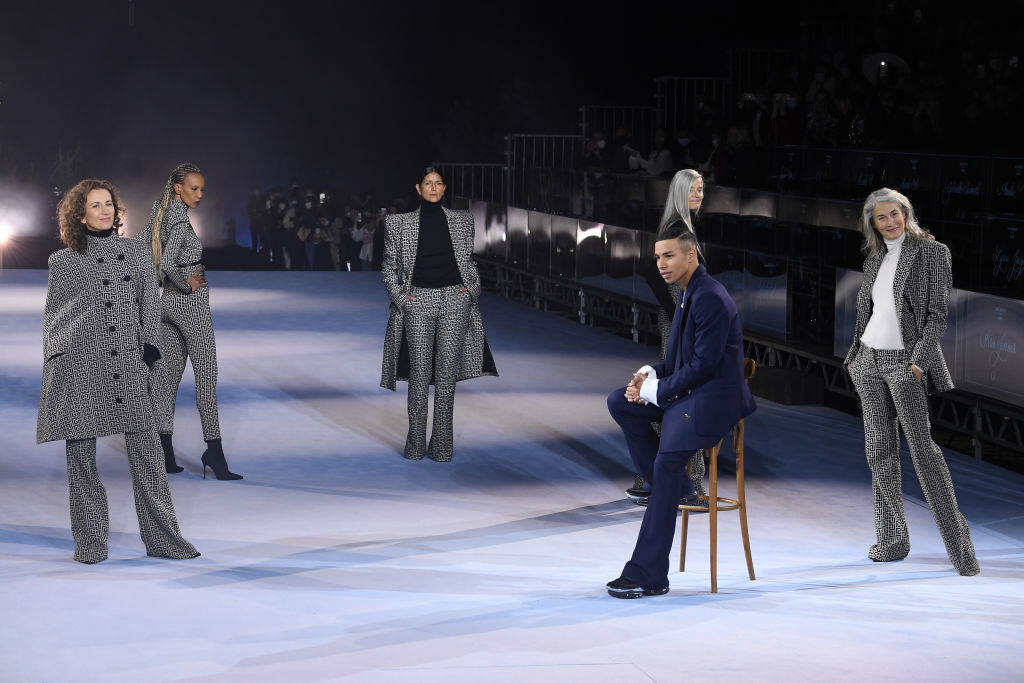The past is now shining vividly in a world of fashion that constantly thirst for novelty. It seems to be contradictory, but it is undeniable that the past is revived in the present and brightly illuminates the future. “Building the future means a deeper understanding of the past,” said Olivier Rusting, creative director of “Balmain”. In the Spring / Summer 2021 collection, he reprinted the two-tone monogram released by the founder of brand, Pierre Balmain, in the 1970s. In the early part of the show of SS21, which was held in Paris on September 30, Olivier and the six looks appeared on the stage who was wearing the archive with the two-tone monogram, adopted the voice of Pierre talking about the brand.
Balancing the brand’s DNA with a contemporary approach is the most difficult task for creative directors. Whether they continue to protect their heritage and lose its brilliance, or the brand is hijacked by a creative director and lose its heritage. Under such circumstances, returning to the origin of the brand and superimposing the past on the needs of the present is a big trend that has become established in recent years. “During the two-month lockdown, I considered how I should build the world and the future of tomorrow,” Olivier continued to explain why he has decided to reprint the monogram. “Digital, millennials, and the future were on the agenda, and I researched the archives. Then I came across the monogram and told myself, ‘True luxury is timeless,’ because no one is spending money on-trend value, not timeless value. “
In “Dior”, the saddlebag was relaunched in 1999 by then-creative director John Galliano. The current creative director Maria Grazia Chiuri renewed it with some tweaks in 2018. With the reprint of the classic, brand’s legacy will continue to grow in value. Donatella Versace has reprinted many archives in the Spring / Summer 2018 collection as a tribute to her brother Gianni Versace, the founder of “Versace”, who died in 1997. Donatella said at the time that silhouette was the only change from the original design, “true value can be reproduced indefinitely without dying.”

PARIS, FRANCE – SEPTEMBER 30: Olivier Rousteing and models are seen on the runway during the Balmain Womenswear Spring/Summer 2021 show as part of Paris Fashion Week on September 30, 2020 in Paris, France. (Photo by Pascal Le Segretain/Getty Images)
Another option is to rewrite the code to modernize the brand’s image. In “Burberry”, Riccardo Tisci created a monogram with the initial TB of the founder. “Gucci” by Alessandro Michele created a motif of GG monogram with a flora print and “Bottega Veneta” by Daniel Lee also focuses on signature intrecciato. While the reprint has a bright future, some designs keep you breathing as a living heritage without being removed from the collection. A typical example is the 101801 coat of “Max Mara”. Designed by Anne Marie Beretta in 1981, this coat has been in the same pattern for almost 40 years. No matter how many times other brands imitate it, the value of “Max Mara” does not fade and it embodies universality in the fashion world.
The recent growth of the resale market is one of the reasons the iconic design is increasing in demand. The rise of resale sites for luxury brands such as Vestiaire Collective and The Real Real have even changed consumer practices. According to The Smart Side of Fashion 2020 Report by Vestiaire Collective, Generation Z and millennials tend to have a strong consciousness to purchase in order to reduce consumption and rationalize better things as they receive a lot of information on the Internet and are eco-conscious. For them, timeless iconic products have the great advantage of not being short-lived. It is also more likely to get higher prices when resold than trending items, so it is recognized as a wise option.
These changes in consumer practices are affecting the industry as a whole. “Schiaparelli,” born in 1927, developed the first ready-to-wear from the Spring / Summer 2020. The artistic director is Danielle Rose Russell, who was the design director of “Tom Brown.” Once “Schiaparelli” created sensational styles such as dresses made with Jean Cocteau and lobster dresses made with Salvador Dalí but closed the brand after World War II. In 2013, guest designer Christian Lacroix revived, then Marco Zanini and Bertrand Guyon have worked as artistic director to develop haute couture. Besides, “Balenciaga” will revive haute couture, for the first time in 53 years since its founder Cristobal Balenciaga created. It was scheduled to be launched this year though, postponed into July next year due to the pandemic. “Patou” is a successful example of brand’s resurrection. It started as a couture brand in 1919 and fell asleep for a long time in 1987. After being acquired by the LVMH Moet Hennessy Louis Vuitton Group in 2018, Guillaume Henri, who has experience with “Carven” and “Nina Ricci,” was appointed as the artistic director. The first collection, SS20 ready-to-wear, was a good start.

UNITED STATES – JANUARY 01: The stylist Jean PATOU choosing his models in the United States for his French atelier. (Photo by Keystone-France/Gamma-Keystone via Getty Images)
“Fashion is more and more obsessed with the past,” said Arnaud de Lummen, CEO of Luvanis. The company is a Luxembourg-based property management company known for selling the trademark rights of “Vionnet,” “Moynat,” and “Paul Poiret,” and reviving many brands. Arnaud says “cultural assets” are the reason for investing in the old brand’s revival rather than the young. “They are part of collective memory, featured in history books, exhibited in museums and usually inspiring contemporary designers. They might come with ready-made monograms or signature products. Equity, history, authenticity, and rich storytelling they have. ‘Sleeping beauties’ are also pristine and offer a relatively blank canvas to write new codes. Consumers do not just buy a product, they buy a brand which was purchased by older generations and which can probably still mean something in 100 years.” Arnaud has helped revive many brands, but says sleeping-beauties business model is no recipe to success. “Combination of great heritage, retrospective and visionary design, good management, investment and a bit of luck.”
In a society where the flow continues to accelerate and the future is unclear by the pandemic, the heritage seems to be regarded as a “comfort shelter.” The unchangeable past looks more attractive than the unpredictable future. However, this is just a temporary shelter. Even if the revival method is added, an equation, society, civilization, and people are heading for the future, not the past. We will learn and make use of it by stopping once at the “comfort shelter” for evolution., and looking back on the past will be a major turning point in the future.


